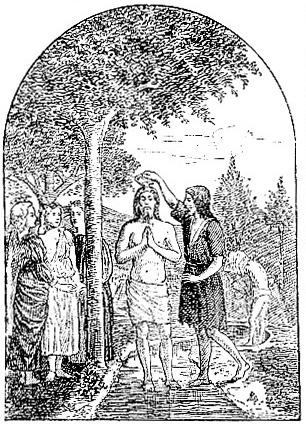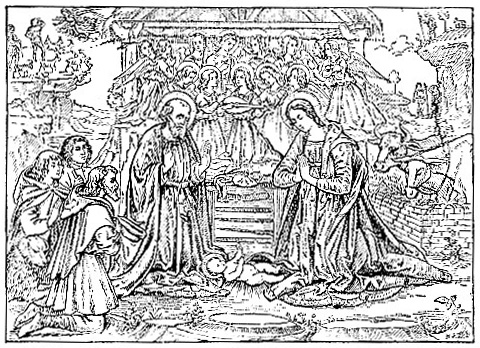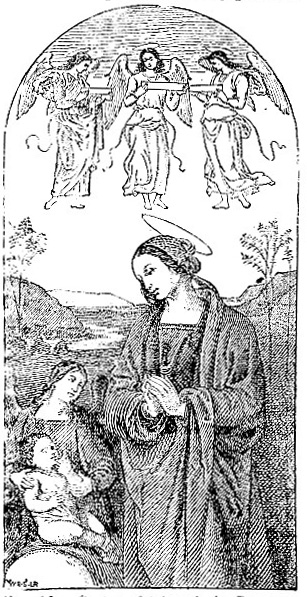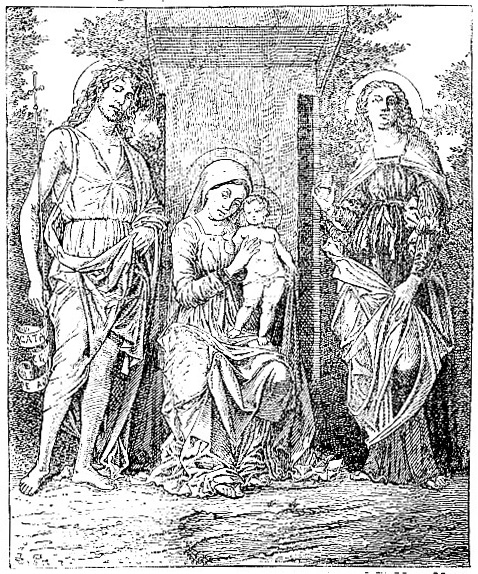1902 Encyclopedia > Schools of Painting > Schools of Umbria, Padua and Arezzo (Italy)
Schools of Painting
(Part 5)
School of Umbria (Italy)
Between the end of the 14th and the beginning of the 16th century the Umbrian school produced many painters of great importance grouped around number of different centers, such as Gubbio, where Ottaviano Nelli lived; San Severino, with its two Lorenzos; Fabriano, famed for its able masters. Allegretto Nuzi and Gentile da Fabriano; Foligno, whence Niccolo took his name; and above all Borgo San Sepolcro, where Piero della Francesca was born.
Piero was one of the most charming of all painters for his delicate modelling, tender color, and beauty of expression (see fig 10). His masterpiece, a large altar-painting of the Madonna enthroned with standing saints at the side and in front a kneeling portrait of Duke Federigo da Montefeltro, in the Brera gallery, is, strange to say attributed to his pupil Fra Carnovale. (Footnote 435-2)

Fig. 10 -- Baptism of Christ, by Piero della Francesca. (National Gallery.)
Gentile da Fabriano worked in the purely religious and richly decorative style that characterized Fra Angelico at Perugia.
Fiorenzo ti Lorenzo (see. Fig. 11) and Bonfigli prepared the way for Perugino (see fig. 12) and his pupils Pinturiccho, Raphael, Lo Spagna, and others.

Fig. 11 -- The Adoration of the Shepherds, by Fiorenzo di Lorenzo. (Gallery at Perugia.)

Fig. 12 -- Centre of triptych, by Perugino, painted for the Certosa naear Pavia. (National Gallery.)
Timoteo Viti was another Umbrian painter of great ability, whose portrait by Raphael in black and red chalk is one of the most beautiful of the drawings in the Print Room of the British Museum.
School of Padua (Italy)
The Paduan school is chiefly remarkable for the great name of Andrea Mantegna, the pupil of Squarcione; his firm and sculpturesque drawing is combined with great beauty of color and vigorous expression (see fig. 13). His pupil Montagna also studied under Gian. Bellini at Venice.

Fig. 13 -- The Madonna between St John Baptist and St Mary Magdelene, by Andrea Mantegna, on canvas. (National Gallery.)
Andrea Mantegna influenced and was influenced by the Venetian school; to him are attributed many of the early paintings of his brother-in-law Gian. Bellini, such as the Vatican Pieta, and other works more remarkable for vigor than for grace.
School of Arezzo (Italy)
The school of Arezzo was early in its development. Margaritone, who is absurdly overpraised by his fellow-townsman Vasari, was an artist of the most feeble abilities. In the 14th century Arezzo produced such able painters as Spinello di Luica, Niccolo di Gerini, and Lorenzo di Bicci. In the 15th century it possessed no native school worth recording.
Footnote
435-2 The attribution of this magnificent picture to Fra Carnovale rests wholly on a statement, evidently erroneous, of Pungileoni; and hence many other works by Piero, such as the St Michael at the National Gallery, are wrongly given to Carnovale. It is doubtful whether any genuine picture by the latter is now known; if the Brera picture were really by him he would not only be greater than his master Piero, but would be one of the chief painters of the 15th century.
Read the rest of this article:
Schools of Painting - Table of Contents
|



